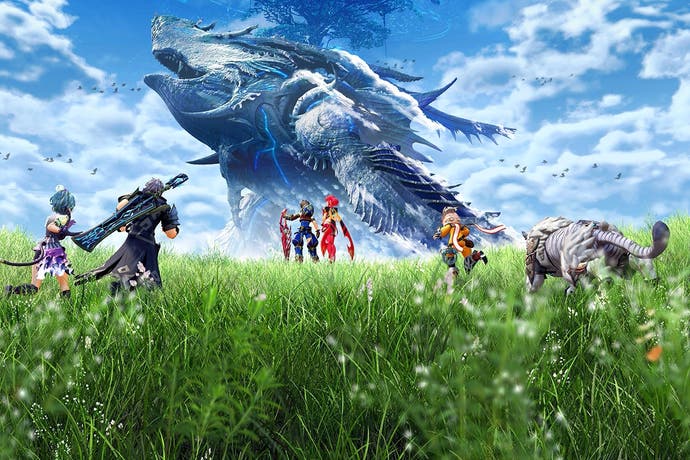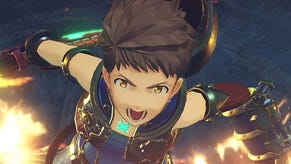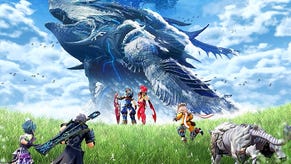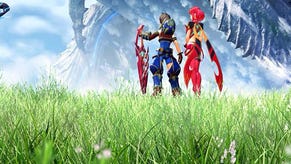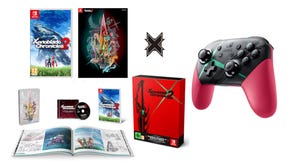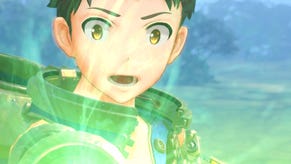Xenoblade Chronicles 2 review
Vivat Rex.
Rex is a boy whose virtues are so gleamingly obvious and uncomplicated that they threaten to render him friendless. He spends his days industriously, niggling at sea beds in a Victorian diving costume - all brass and glass curves - salvaging trinkets from wrecks. Only the bare minimum of the profits Rex earns from this work are kept: he dutifully sends the rest home to support his distant, impoverished family. Together with his friend and father-figure, Azurda, a dragon-Muppet on whose back Rex rides (and, rather rudely, on which he has erected a rusty salvage crane) the pair tour the cloud sea without complaint or quarrel. Who can stand to be around that kind of blinding decency for long?
Certainly not the writers of Xenoblade Chronicles 2. They soon interrupt Rex's wholesome routine with the offer of a freelance contract accompanied by such an eye-wateringly tall fee that Rex agrees to the job before asking for any of the details. Naivety and virtue have always been the twin characteristics of the RPG protagonist: the former is necessary to draw the hero into the story's grand mess, the latter to empower them to triumph over it. But it's one of only a few clichés to be found in Xenoblade Chronicles 2, a game that is just as wildly ambitious and imaginative as its celebrated predecessor. Once he becomes a killer, even Rex becomes bearable.
In Xenoblade Chronicles 2, humanity is a parasite that lives on the backs of Titans, continent-sized mythical beings whose limbs stretch as great plains off into the distance, whose spinal columns rise like the Himalayas, and whose guts drop like caverns. The Titans are so tall that the clouds through which they once burst have become the sea on which humans sail. They're also, it turns out, dying. And when a Titan dies it's bad news for everyone who live on its surface: their world collapses.

It's a setting in which the team at Monolith Soft, who, earlier this year, provided support in building the latest version of Hyrule for Nintendo, flourish. Every landscape is, at once, beautifully familiar and alien: we recognise the fields and copses, the rocky outcrops and dizzying cliffs, but the arrangement is pleasingly off. Trails lead upward in grand spirals. The Titans' bodies provide meshes and struts, femurs and columns that take you up, up, up through vast natural cathedrals.
This much was also true of the Wii U's Xenoblade Chronicles X, a pseudo spin-off to the 2010 original which provided similar exploratory joys. This formal sequel, however, is a much more focused piece of narrative work in which you're bustled along clear plot lines via story missions pausing only, if you so wish, to aid the residents of the various cloud cities you visit. These side-missions are often plain, but they serve a grander purpose: as you, for example, clean up the industrial pollution spoiling a local river, or solve some local petty crime mystery, you enrich the city (your civic relationship to which is quantified by a five-star rating), unlocking new items in the local shops as you do so.
Those who choose to ignore the little problems along the way are nevertheless kept well-occupied. Rex soon meets Pyra, a curious and guarded woman who, it seems, everyone wants a piece of. Rex, in his naivety, decides to become Pyra's protector. He pledges to deliver her to Elysium, a place where they will both be safe from the crashing death of any Titan. The damsel-in-distress cliché is upset by the fact that Pyra is a Blade, a character upon whom Rex wholly relies to provide power and energy to him in battle. Without her, he is a weakling. As with the humans and the Titans, through symbiosis, the pair's fates are intertwined.

The relationship also provides the framework for the game's battle system, arguably its brightest and most intricate jewel of design. In battle your three party members (each of whom is supported by a Blade like Pyra) automatically attack enemies. As they do so, they build meter which can be used to execute more powerful 'Arts'. Arts, when powered up, can be strung into wild combinations, toppling enemies before sending them spiralling into the air, ripe for the finishing move that's delivered with a virtuosic flourish. Individual Arts can be set on a per character basis, and separately levelled up, and the Blade you use to support each of your characters further alters the strategic options that are available. The system is revealed slowly, so that, even in its most chaotic latter stages, an able player will be able to keep track of precisely what is happening among the firework display of particles and barked war-cries.
New Blades are unlocked regularly via crystals. These work a lot like loot boxes in that you never know which one you're going to get. While most common Blades that you collect are generic, occasionally you'll unlock a special named Blade, a legendary fighter with exquisitely drawn accompanying art and full voice acting, and collecting all thity-odd of these rare beings becomes a Pokémon-esque occupation.
The vast majority of Blades grow in power and abilities through either use on the battlefield or when specific criteria are met. Poppi, a steam-powered robot, is a notable exception, with an entire minigame associated to her development. New parts for Poppi can be scavenged via an Atari 2600-style arcade game, in which you must guide a diver toward the seabed, dodging hazards and collecting coins and flotsam. It's a terribly involved time-sink, but with every Blade, the benefits of investment extend far beyond the battlefield. Each Blade comes with other 'field' skills which, once improved, enable you to unlock treasure chests, create shortcuts and, in some cases, open up entire new areas of the world.

These core systems combine to compelling effect. Every action contributes to progress in another area, so no effort ever feels like it's misplaced. As with so much of Takahashi's work, including the barely finished Xenogears, however, the game is filled with bright ideas that aren't quite fully explored or exploited. The cloud sea, for example, is tidal. When the clouds gather around the Titan continents, like mist on the shins of a forest, access to some locations opens up and others closed down. Stay a full night at an inn and the tides change. Ingenious, except the concept is barely used.
Occasionally too, the game's freedoms become impediments. Battling a group of monsters in the wild is risky as passers-by may be inspired to pile in. You may defeat a particularly strong enemy (known, grandly, as a 'named monster') only to be defeated by an opportunistic weakling who spied an opportunity to take down a beleaguered squad. Likewise, in a world that is built with such architectural abandon, all vertical spirals and warren-like chambers, Xenoblade Chronicles 2's map is utterly unfit for purpose. By far the greatest frustration in the game is trying to figure out where the arrow you are following intends for you to go; hours can be lost to the game's poor automated plotting, and kindergarten-esque map.
For all its ingenuity - and this is a story equally and tastefully tinged with humour and tragedy - the game's script is let down by some risible voice acting. The two leads, Rex and his co-fighting companion Nia, are expertly voiced with pleasingly regional accents (in particular, Nia's thick Welsh twang never fails to delight) but the supporting cast is unendurably poor. The game also suffers, as Takahashi's work has in the past, from character design that plays to anime's worst provincial tendencies. The simpering Pyra eventually reveals hidden depths on the inside, but her back-ruining bust is nothing short of an adolescent assault on human biology.
Xenoblade Chronicles 2 is a crunchier, more chaotic proposition than the rest of Nintendo's recent output, then. Monolith Soft either doesn't have the resources or the relentless tenacity to explore every one of its game mechanics with the rigour and finality of Nintendo EAD. But while the game's individual components are far from pristine, in combination they prove irresistible. And as with Rex, it is to the wrinkles and idiosyncrasies that we are ultimately drawn, and ultimately convinced.
